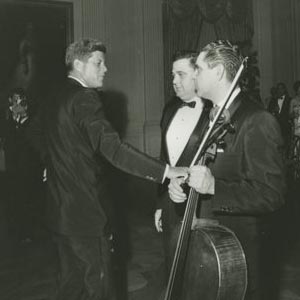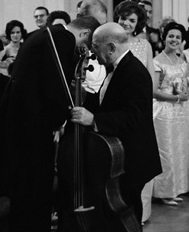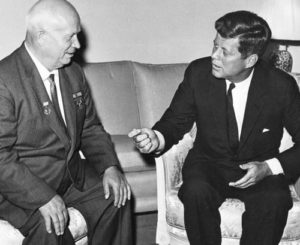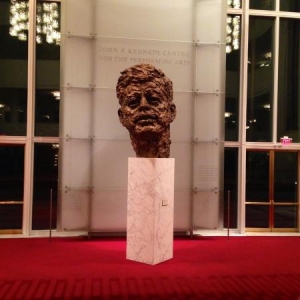“I had the honor of playing at the White House in 1962 for President Kennedy. It was a great event in honor of André Malraux and the arrival of the Mona Lisa, which was to be exhibited in Washington. With my friends and colleagues of the Trio, Isaac Stern and Leonard Rose, we spent an hour and a half after the concert in the President’s private apartments. With us, there were only André Malraux, who essentially spoke with Jackie Kennedy, Hervé Alphand, the French ambassador, Leonard Bernstein, Charles Lindbergh and his wife. It is a fantastic memory for me. We were all standing, as the President could not sit down because his back was too painful. Amazingly, Kennedy was questioning everyone and anxious to listen. He gave an astonishing, touching feeling of openness and vulnerability.”
Istomin had been a strong supporter of John Fitzgerald Kennedy in the 1960 elections, to the point of engaging in major political discussions at post-concert receptions, even in Republican territory. This earned him a call to order from his management, recommending that he no longer express his political opinions. He was never again invited to certain cities in Texas. Thanks to two journalist friends, Henry Brandon and especially Henry Raymont, Istomin had access to the highest echelons of power. He also forged a close and lasting friendship with Pierre Salinger, the White House spokesman.
One of the points that had attracted Istomin’s attention was the desire to put culture at the forefront of political life. Thanks to Abe Fortas and Henry Raymont, Kennedy succeeded in convincing Casals to come to the White House and play. This concert had a considerable impact around the world. As a symbol of his commitment to equal civil rights, Kennedy invited Grace Bumbry, who was the first black singer to perform at the White House. He also welcomed the Sextet of the saxophonist Paul Winter, the first ever jazz concert at the White House, which included as many whites as blacks. Another event of great political significance was the recital given by Han Tong-il, a young Korean pianist who had fled from the North to the South, where he had been detected by the American military. He was sent to the United States and studied at the Juilliard School with such success that he won the Leventritt Competition.
When Istomin played on May 11, 1962 with Isaac Stern and Leonard Rose in honor of André Malraux, Kennedy invited the finest American artists and writers, from George Balanchine to Tennessee Williams. Before the concert, there was a sumptuous cold dinner, served with a Château-Petrus and Dom Pérignon champagne. Istomin was frustrated at not being able to eat or drink! The concert was shortened, with only Schubert’s Trio in B flat major, as President Kennedy was in such pain from his back that he could not sit for long.
This was followed by the privilege of being privately received in the White House apartments. Kennedy admitted without fuss that he knew nothing about music, but Istomin readily forgave him. What amazed him was Kennedy’s forthright simplicity, and his willingness to listen to all the ideas and suggestions which could be useful to him for the running of the country and the world. When at some point Istomin dared to suggest that he regularly address Americans directly on the radio without the intermediary of journalists, Kennedy took this suggestion seriously, replying: “You mean like the Roosevelt fireside chats? I believe that for this I do not have his charisma.” And in fact, Kennedy, fascinated by the power of the image, continued exclusively with his television press conferences.
Istomin emerged from that evening completely seduced by Kennedy, and spoke non-stop about it to all his friends in exalted terms! He was willing to take up Kennedy’s exhortation: “My fellow Americans, ask not what your country can do for you, ask what you can do for your country.” And the best he could offer was to put his talent at the service of his country and his president, to go and play wherever it would serve America’s image. Russia had managed to appear as a great country of culture by sending Oistrakh, Gilels and Richter, while the United States usually delegated second-rate artists. Not only was Istomin at the disposal of the State Department, but he also undertook to persuade his most prestigious colleagues – Bernstein and Maazel, Stern and Menuhin, Fleisher, Graffman, and van Cliburn, to join forces. All were willing to go without any fee. Istomin initiated the experience by taking on a long mission in Bulgaria in April 1963, followed by a concert in Tehran.
Kennedy’s assassination on November 22, 1963, came as a great shock to Istomin, and resulted in an even greater willingness to serve his country and to become more involved in politics. Thanks to Abe Fortas, who was very close to Johnson, and Humphrey, who became Vice President in January 1965, Istomin remained in contact with the highest levels of power. He used his best efforts to support Humphrey at the 1968 presidential election.
In 1971, for the inauguration of the Kennedy Center, Istomin was invited to give the first chamber music concert there with his friends Isaac Stern and Leonard Rose, in the presence of top American personalities, the entire diplomatic corps, and media from around the world. The evening began with the reading of a long and moving letter from Casals in tribute to Kennedy. It ended with a prolonged standing ovation for the musicians.
In November 1983, the Istomin-Stern-Rose Trio participated in the gala concert held to commemorate the 20th anniversary of Kennedy’s death. It was to be their last concert and was a moving symbol of the end of their adventure. At that time, Marta Istomin was the artistic director of the Kennedy Center and remained so until 1990.
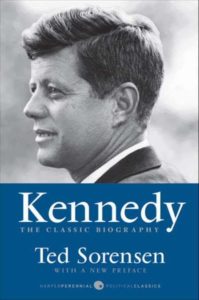 Over time, certain aspects of Kennedy’s personality were revealed, and the record of his presidency was significantly depreciated. Istomin felt that he had been “smitten by Kennedy mystique”, or as he told James Gollin, by the “Camelot thing”. So many intellectuals had been taken in by the skillful political communication orchestrated by Salinger and Sorenson, who happened to be friends of Istomin’s! Istomin distanced himself, while remaining aware that optimism and idealism in politics were still possible at that time. Kennedy had symbolized them beyond the reality of his persona and his actions. The Vietnam War, the succession of political assassinations, and the Middle East crisis would bring humanity back to sadder realities.
Over time, certain aspects of Kennedy’s personality were revealed, and the record of his presidency was significantly depreciated. Istomin felt that he had been “smitten by Kennedy mystique”, or as he told James Gollin, by the “Camelot thing”. So many intellectuals had been taken in by the skillful political communication orchestrated by Salinger and Sorenson, who happened to be friends of Istomin’s! Istomin distanced himself, while remaining aware that optimism and idealism in politics were still possible at that time. Kennedy had symbolized them beyond the reality of his persona and his actions. The Vietnam War, the succession of political assassinations, and the Middle East crisis would bring humanity back to sadder realities.
Istomin remained on friendly terms with the youngest of the Kennedy brothers, Ted, who wrote to him in 2000, for his 75th birthday: “You have enriched all of our lives with musical greatness and acts of selfless friendship.”
It should be noted that Roger Sessions’ Third Sonata, subtitled the “Kennedy Sonata”, is dedicated to Eugene Istomin. The beginning of the last movement was inspired by the assassination of John Fitzgerald Kennedy.
Music
On the twentieth anniversary of Kennedy’s death, Istomin, Stern and Rose came to the Kennedy Center and performed a movement of the Schubert Trio they had played for him at the White House in 1962. This was the last public appearance of the Trio Istomin-Stern-Rose.
Schubert. Trio in B flat major D. 899, Andante. Eugene Istomin, Isaac Stern, Leonard Rose, recorded for Columbia, August 15-17, 1964.
Audio Player
